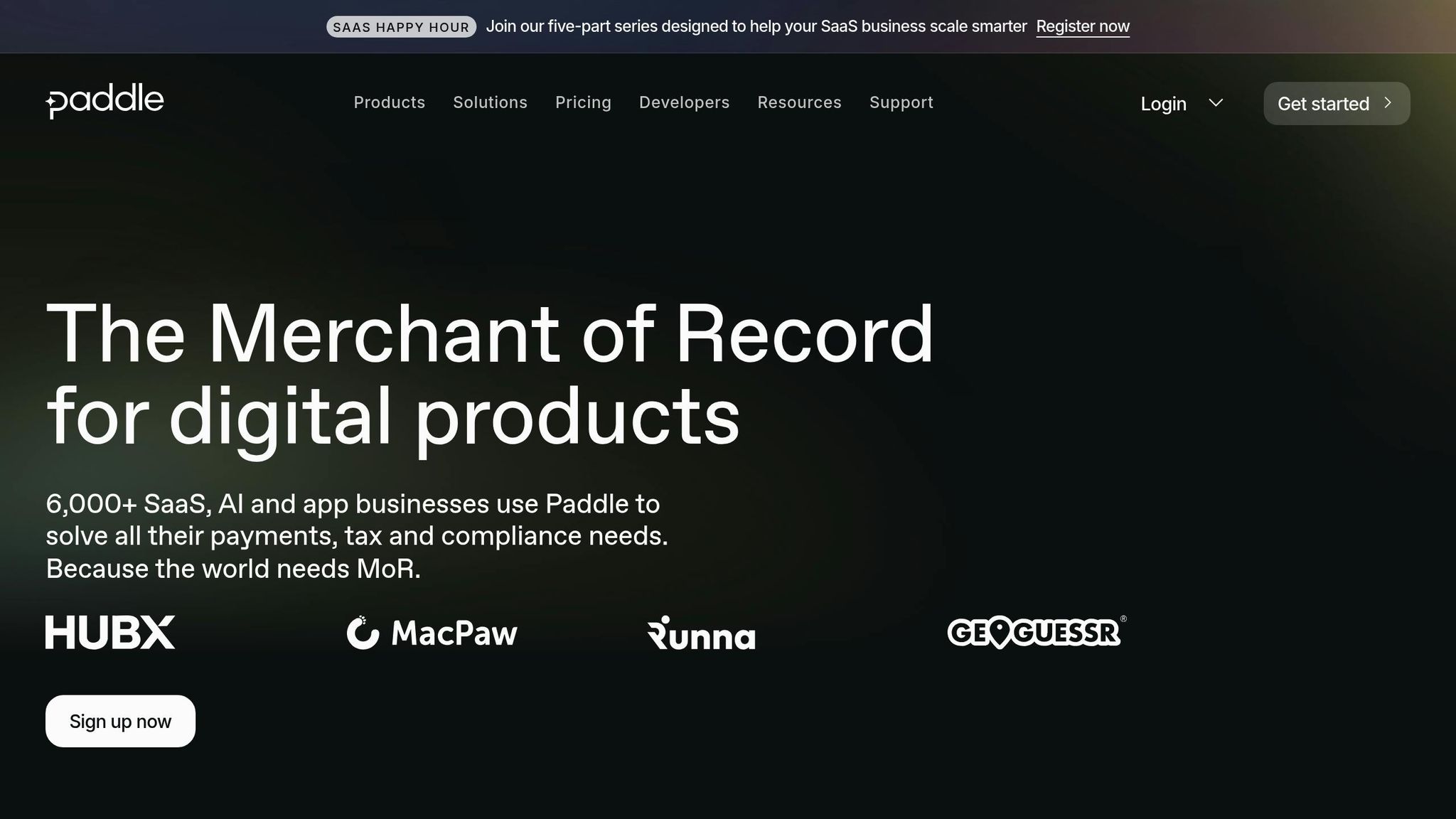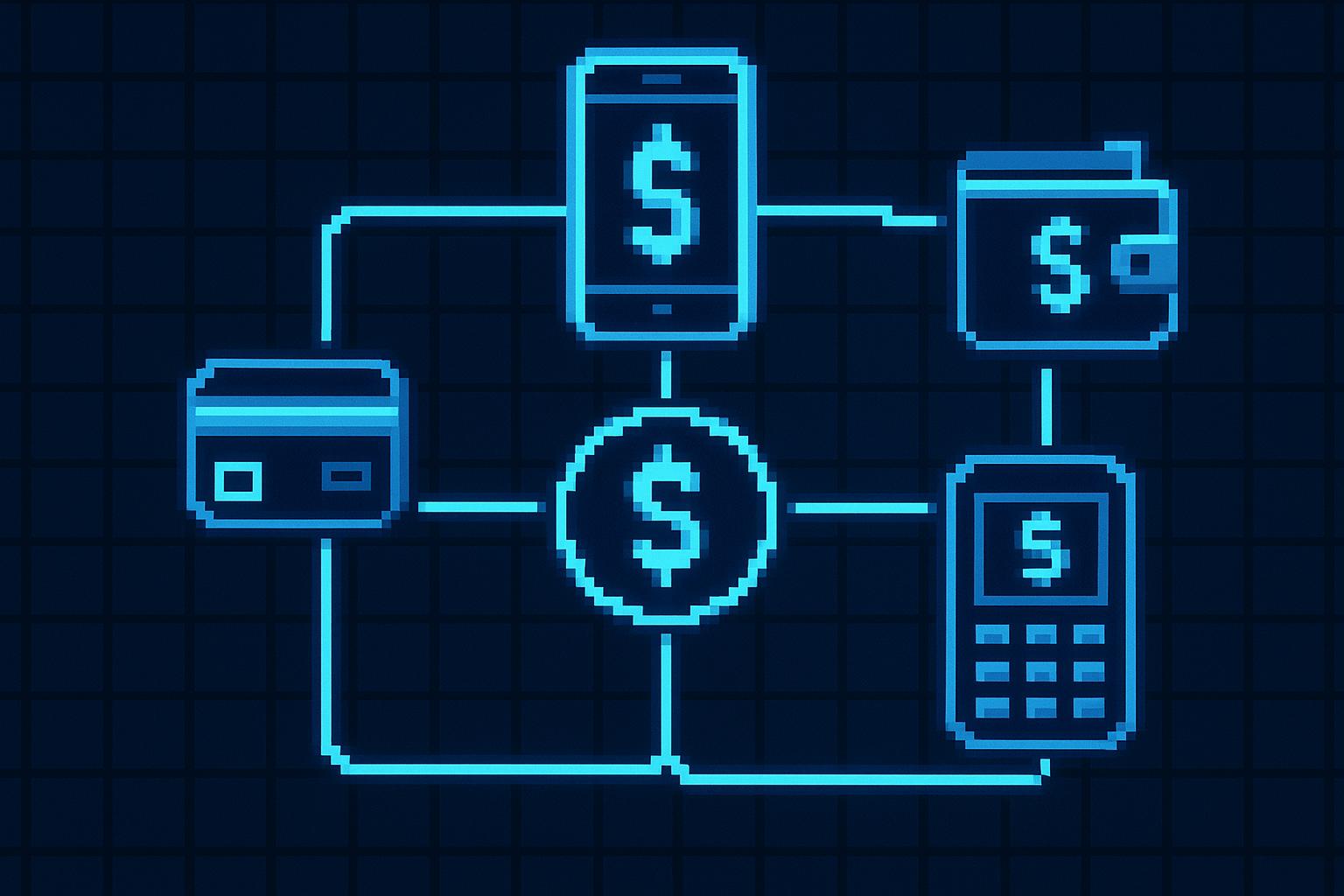If you're deciding between Paddle and Stripe for your SaaS payment processing needs, here's the core takeaway:
- Paddle simplifies payment operations by acting as a Merchant of Record (MoR), managing global tax compliance, subscription billing, and fraud protection for SaaS companies. It charges a flat 5% + $0.50 per transaction, making it ideal for businesses with limited technical resources or those prioritizing ease of use.
- Stripe offers highly flexible, developer-focused tools for businesses requiring custom payment solutions. While its base fee is 2.9% + $0.30 per US transaction, additional costs for features like subscription billing and tax compliance can push total costs to 8% or more of revenue. Stripe is best for companies with strong technical teams and complex billing needs.
Quick Comparison
| Feature | Paddle | Stripe |
|---|---|---|
| Payment Model | All-in-one Merchant of Record | Developer-focused payment platform |
| Pricing | 5% + $0.50 per transaction | 2.9% + $0.30 per transaction (base fee) |
| Tax Compliance | Included (global) | Stripe Tax (extra cost) |
| Recurring Billing | Built-in | Stripe Billing (extra cost) |
| Setup | Low-code, minimal development required | High customization, requires developers |
| Best For | Small teams, global compliance needs | Complex billing setups, technical teams |
Key Decision Factors
- Choose Paddle if you want simplicity, fast implementation, and minimal technical overhead.
- Choose Stripe if you need custom integrations, advanced billing models, and have the resources to manage them.
Your choice depends on your team's technical expertise, business complexity, and whether you value simplicity or control.
paddle vs stripe A Comprehensive Comparison for SaaS Payment Solutions

Paddle Overview
Paddle provides an all-in-one pricing model designed to simplify payment processing for SaaS, app, and digital product companies. By handling complex administrative tasks, it helps businesses focus on growth rather than back-office operations.
Paddle Pricing and Fees
Paddle operates on a pay-as-you-go model, charging 5% + $0.50 per transaction. For businesses with specific needs - such as handling low-priced products or requiring invoicing - custom pricing options are available. What sets Paddle apart is its straightforward pricing structure: no hidden fees, no migration costs, and no monthly charges. This transparency makes it an appealing choice for companies looking to streamline their operations.
Best Use Cases for Paddle
Adam Wathan, CEO of Tailwind Labs, shared his experience:
"With our cross-border payments, we were looking at around 3.5% fees with Stripe and 4.5% with PayPal. So, any savings would have been minimal. You just ask yourself, is any saving worth the admin burden and opening yourself up to extra scrutiny from the tax agencies? Absolutely not."
This insight underscores why Paddle is an excellent fit for businesses that value simplicity and want to avoid the hassle of managing cross-border transactions and related administrative tasks.
Stripe Overview
Stripe is a developer-focused payment platform designed to give SaaS businesses full control over their payment systems. With a strong emphasis on flexibility, Stripe provides tools and APIs that technical teams can fine-tune to meet their unique business needs.
Stripe Features
Stripe delivers a wide range of developer tools and APIs, offering multiple integration options. Whether it's prebuilt payment forms through Stripe Checkout or fully customizable API-only setups, SaaS businesses can create secure, personalized payment experiences that align with their branding and technical goals.
For subscription-based businesses, Stripe includes tools like Stripe Billing, which supports various pricing models such as flat-rate, per-seat, tiered, and usage-based structures. It also enables features like trial management, discounts, and customer self-service portals for updating payment details or viewing billing history.
Developers can take advantage of Stripe's mobile SDKs for iOS and Android, as well as browser-based tools like Stripe Shell, which simplify testing and development workflows.
Stripe’s webhook system allows real-time tracking of subscription events such as upgrades, downgrades, and failed payments. It also automates critical processes like revenue recognition, sales tax calculations through Stripe Tax, and involuntary churn reduction using Smart Retries.
Security is another key focus area. Stripe employs advanced fraud detection with Stripe Radar, leveraging machine learning to flag suspicious transactions. Additionally, the platform ensures PCI DSS compliance and uses tokenization to safeguard sensitive payment data during transactions.
Altogether, these tools equip SaaS companies with the flexibility to craft payment strategies tailored to their specific business needs.
Best Use Cases for Stripe
Stripe is an ideal choice for SaaS businesses with skilled technical teams seeking detailed control over their payment systems. Companies requiring custom billing logic, unique subscription setups, or seamless integrations with existing platforms can benefit significantly from Stripe’s API-driven approach.
The platform is particularly advantageous for fast-growing SaaS companies aiming to scale globally while managing tax compliance, customer data, and payment operations in-house. Additionally, multi-product SaaS businesses can use Stripe’s modular framework to create tailored billing experiences for different product lines, all while maintaining a cohesive payment infrastructure.
sbb-itb-a989baf
Feature Comparison
Take a closer look at the key differences between Paddle and Stripe to determine which one fits your SaaS business needs.
Side-by-Side Comparison Table
| Feature | Paddle | Stripe |
|---|---|---|
| Payment Processing | All-in-one Merchant of Record | Developer-focused payment platform |
| Recurring Billing | Built-in subscription lifecycle management | Modular (Stripe Billing) with additional fees |
| Billing Models | Supports diverse billing models via API | Flat-rate, per-seat, usage-based, flat-rate + overage |
| Tax Compliance | Automatic global tax handling | Stripe Tax (additional service) |
| Technical Setup | Low-code, managed infrastructure | High customization; requires development |
| Plan Changes | Automatic proration for mid-cycle changes | Requires additional configuration |
| Customer Portal | Included in core offering | Available through Stripe Billing |
| Pricing Structure | Flat-rate fee (typically 5% + $0.50) | Base processing fee plus additional charges for billing features |
This table highlights the core distinctions to help SaaS businesses make an informed choice.
Key Differences Explained
Expanding on the table, the primary contrast between Paddle and Stripe boils down to operational simplicity versus technical flexibility.
Stripe is a modular platform that allows you to build a custom payment stack. While this approach offers unmatched flexibility, it also demands significant development resources. Experts often describe Stripe as a developer-first platform, ideal for companies that need complete control over their payment systems.
On the other hand, Paddle adopts a unified, all-in-one Merchant of Record model. This approach simplifies operations, making it particularly appealing to smaller teams or businesses that lack extensive technical resources. Paddle’s managed infrastructure means you don’t have to worry about piecing together multiple tools or managing complex integrations.
Billing capabilities are another area where the two platforms differ. Stripe supports a variety of billing models, but handling complex recurring billing scenarios often requires additional tools or configurations. For example, analyses indicate that businesses using Stripe may need third-party tools to manage intricate subscription setups. Paddle, by contrast, supports diverse billing models through its API and webhook system, making it easier to handle recurring billing without additional software.
When it comes to cost, Stripe's pricing structure includes a base processing fee, with extra charges for billing features like subscription management and tax compliance. Paddle, however, offers a flat-rate fee that covers everything, including subscription management and global tax handling. This can be a significant advantage for businesses looking to simplify their financial operations and reduce unpredictable costs.
That said, Paddle’s streamlined model may not be ideal for every scenario. It can struggle with more complex use cases, such as usage-based billing, marketplace setups, or highly customized subscription flows. Stripe, with its modular design, excels in these areas but at the expense of increased complexity and development effort.
For SaaS companies in the U.S., the choice often comes down to your team’s technical expertise and business priorities. If you have a robust engineering team and need maximum flexibility, Stripe is likely the better fit. But if you’re focused on speed to market and operational ease, Paddle’s all-in-one solution offers a compelling alternative.
When to Choose Each Option
Deciding between Paddle and Stripe boils down to your technical capabilities and business priorities. Here's a closer look at how to determine which platform best suits your needs.
Choose Paddle If
You have a small team or limited finance resources. Paddle is ideal for SaaS companies that want to avoid dedicating time and staff to managing payment operations. If you're focused on product development and prefer to offload the complexities of payment infrastructure, Paddle's all-in-one solution takes care of it for you.
Global tax compliance feels overwhelming. As a Merchant of Record, Paddle takes on the responsibility of calculating, collecting, and remitting sales tax, VAT, and GST across all regions where you operate. This means they handle compliance and liability, letting you concentrate on growing your business while avoiding tax-related headaches and penalties.
You need a quick setup and ready-to-go tools for growth. Paddle's managed infrastructure simplifies deployment, allowing you to start processing payments with minimal engineering effort. The platform also handles subscription management, fraud protection, and dispute resolution automatically, so you can focus on scaling your business.
Your developers need to focus on the product. If your engineering team is better utilized on core product features rather than integrating and maintaining payment systems, Paddle's managed approach ensures your technical resources stay focused on what matters most.
A great example is digital product company Aithor, which saw a 9% revenue boost within just one week of switching to Paddle. This highlights how quickly businesses can benefit when they don't have to worry about payment operations.
Choose Stripe If
You need full customization and flexibility. Stripe's API-first design gives you complete control over your payments. If your SaaS business has unique billing needs, intricate subscription models, or requires deep integration with existing systems, Stripe's modular platform can handle it all.
You have a strong in-house development team. Stripe requires technical expertise for effective implementation and ongoing management. If you have skilled developers who can handle integrations, tax compliance tools, and custom subscription logic, Stripe's flexibility becomes a major advantage.
Your business model is complex or unconventional. Whether it's usage-based billing, marketplace transactions, multi-party payments, or highly tailored subscription flows, Stripe's extensive features and third-party integrations can handle even the most intricate payment scenarios.
You prefer to control compliance and operations. Some SaaS companies want to manage tax compliance, subscription management, and customer support themselves. Stripe provides the payment processing infrastructure but leaves these functions in your hands, giving you complete control.
Business Factors to Consider
Technical resources. If your team has limited technical bandwidth or you'd like to minimize engineering efforts for payment operations, Paddle's all-in-one solution is a better fit. On the other hand, Stripe requires more developer involvement but offers unmatched customization.
Compliance needs. For businesses selling globally, Paddle's Merchant of Record model eliminates the complexities of managing tax compliance across multiple regions. However, if you prefer to handle compliance internally or need specific regulatory customizations, Stripe's flexibility may be better suited.
Company size and growth plans. Smaller SaaS companies often benefit from Paddle's simplicity and integrated support. In contrast, larger enterprises with more complex needs might find Stripe's advanced features and customization essential for managing their operations.
Conclusion
Main Differences Summary
Paddle and Stripe take two very different approaches to payment processing, each with its own strengths. Paddle simplifies operations with its all-in-one model, acting as a Merchant of Record. It handles tax compliance, subscription management, and payment operations, making it a great fit for SaaS companies that want to focus on building their product instead of managing payment infrastructure. With Paddle, you get a quicker setup, built-in fraud protection, and minimal need for technical resources.
On the other hand, Stripe offers unmatched flexibility with its API-first platform. You retain full control over payment processes, customer relationships, and compliance. While this approach demands more from your development team, it opens the door to creating tailored billing models and custom integrations. These differences highlight the trade-offs you’ll need to weigh when choosing the best platform for your needs.
Decision Guidelines
The choice between Paddle and Stripe boils down to whether you prioritize ease of use or technical flexibility.
Paddle is a good fit if:
- You're a growing SaaS company with limited technical resources.
- Navigating global tax compliance feels daunting.
- Your engineering team needs to stay focused on developing core product features.
- You want a faster time to market with a streamlined setup.
Stripe is ideal when:
- You have specific needs that require customization.
- Your development team is equipped to handle its flexibility.
- Your business has complex billing models, marketplace features, or unique subscription requirements.
- You need robust API capabilities to support your operations.
When deciding, think about your long-term growth plans. Paddle's simplicity can help you move quickly now, but consider whether its limitations might hold you back as your business scales. Conversely, Stripe offers endless possibilities, but keep in mind the ongoing technical effort required to manage and maintain its advanced features.
Ultimately, the decision hinges on how you view payment processing within your business. If payments are a core part of your competitive edge, Stripe's customization and control make sense. If you see payments as a utility that should run seamlessly in the background, Paddle’s managed solution is likely the better choice.
FAQs
What should I consider when deciding between Paddle and Stripe for my SaaS business?
When deciding between Paddle and Stripe, it’s essential to consider what aligns best with your business goals and operational needs.
Paddle is an all-in-one solution designed to simplify processes like tax compliance, chargebacks, and billing. It’s particularly appealing to SaaS companies that want a Merchant of Record to handle taxes, refunds, and other administrative tasks. While this convenience streamlines operations, it does come with slightly higher transaction fees.
Meanwhile, Stripe offers unmatched flexibility and control. With its customizable checkout flows, developer-friendly APIs, and advanced fraud detection tools, Stripe is a strong option for SaaS businesses aiming to scale and create a tailored payment system. However, managing tax compliance and other backend processes requires more setup and effort.
The choice ultimately boils down to your priorities: if simplicity and built-in support are key, Paddle might be the better fit. If you need flexibility and customization to grow your payment infrastructure, Stripe is worth considering.
How does Paddle make global tax compliance easier for SaaS businesses?
Paddle takes the hassle out of global tax compliance by serving as the Merchant of Record. This means it takes care of calculating, collecting, and remitting VAT, GST, and other sales taxes for you. SaaS businesses no longer need to register in multiple countries or navigate the maze of tax filings.
With these processes automated, Paddle lightens your administrative load and minimizes the risk of tax-related issues. This frees up SaaS companies to concentrate on growing their business worldwide - without getting bogged down by tax complications.
How much technical knowledge is needed to set up and manage Stripe’s payment solutions?
To make the most of Stripe's flexible payment solutions, a good grasp of technical concepts is crucial. You'll need skilled developers who are well-versed in API integration, understand payment processing workflows, and can ensure compliance with security standards like PCI DSS. While Stripe provides extensive tools and documentation, having a solid technical team is key - especially if your business has more intricate requirements.


